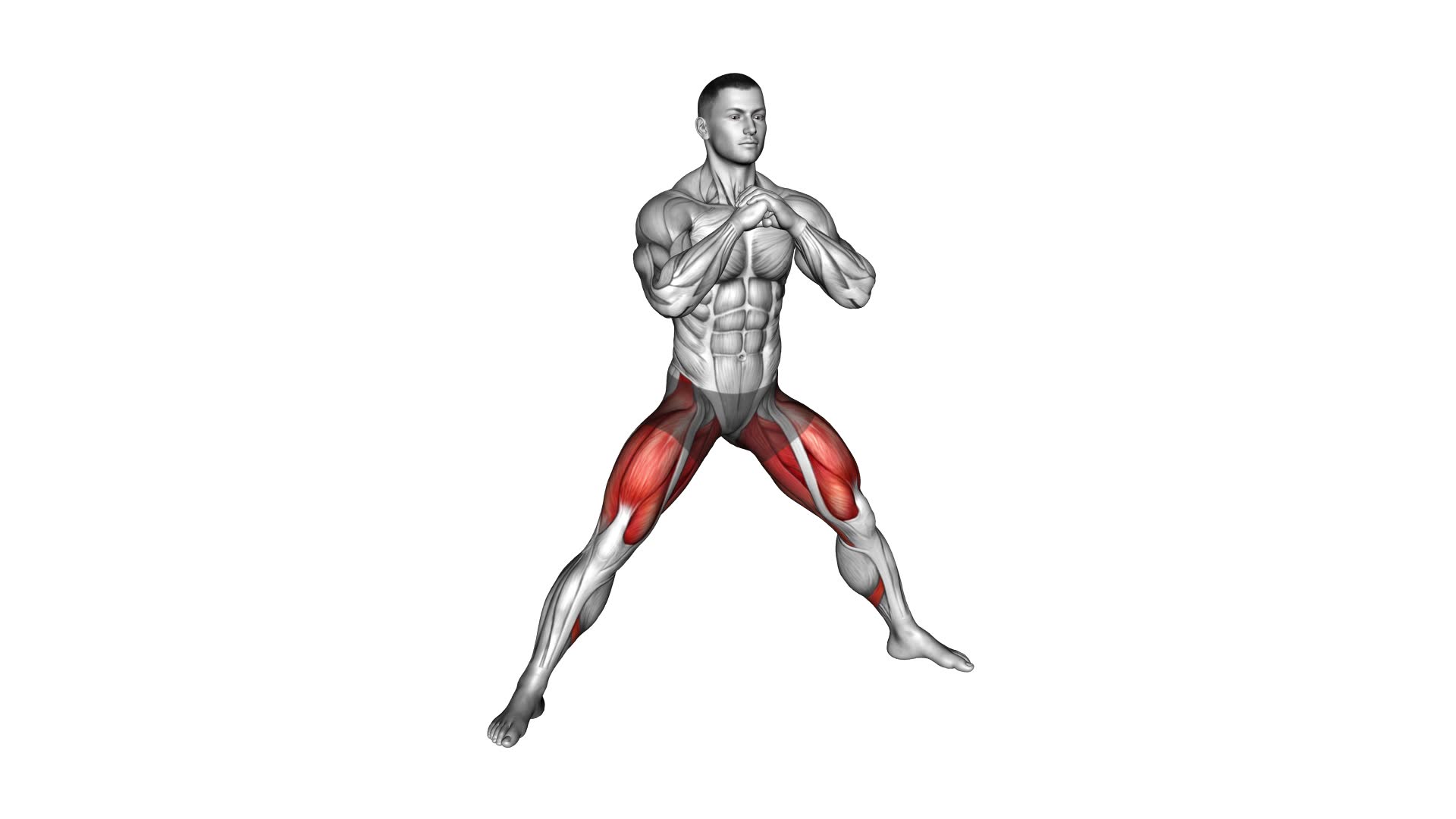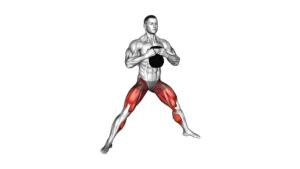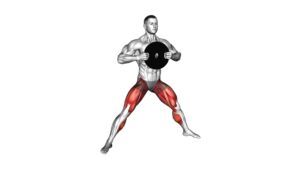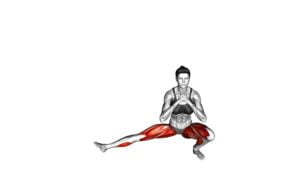Cossack Squat – Video Exercise Guide & Tips

Get ready to level up your leg workout with the Cossack squat! In this video exercise guide, we'll show you the proper form and technique to perform this challenging yet effective exercise.
Watch This Exercise Video
Avoid common mistakes and learn variations and progressions to keep pushing your limits.
With our expert tips, you'll maximize your Cossack squat workout and take your lower body strength and flexibility to new heights.
Let's dive in and get those legs firing!
Key Takeaways
- Cossack squats increase lower body strength and improve hip mobility.
- They engage muscles in the glutes, quads, and hamstrings.
- Cossack squats enhance balance and stability and can help prevent knee injuries.
- Proper form and technique are important, including starting with feet wider than shoulder-width apart and keeping the chest lifted and back straight.
Benefits of the Cossack Squat
Discover the numerous benefits of incorporating the Cossack squat into your workout routine. This exercise not only helps to improve your overall fitness, but it also offers a range of health benefits and muscle activation.
One of the key health benefits of the Cossack squat is its ability to improve flexibility and mobility. By performing this exercise regularly, you can increase the range of motion in your hips, knees, and ankles. This is particularly beneficial for athletes or individuals who participate in activities that require a wide range of motion, such as dance or martial arts.
In addition to improving flexibility, the Cossack squat also activates multiple muscle groups. This exercise primarily targets the quadriceps, hamstrings, and glutes, helping to strengthen and tone these muscles. It also engages the core muscles, including the abdominals and obliques, for stability and balance.
Furthermore, the Cossack squat can help to improve your balance and coordination. As you perform the exercise, you're required to shift your weight from side to side, challenging your body's ability to maintain stability. This can translate into improved balance and coordination in other activities or sports.
Incorporating the Cossack squat into your workout routine can provide numerous health benefits, including improved flexibility, increased muscle activation, enhanced balance, and coordination. Make sure to perform this exercise correctly and gradually increase the intensity to maximize its effectiveness.
Proper Form and Technique
To perform the Cossack squat with proper form and technique, start by standing with your feet wider than shoulder-width apart.
Here are some tips to ensure you're executing the exercise correctly:
- Maintain a straight back: Keep your spine aligned throughout the movement to avoid strain or injury. Engage your core muscles to support your posture.
- Lower your body: Begin by shifting your weight to one side as you bend the knee of that leg, while keeping the other leg straight. Lower your body until your thigh is parallel to the ground. Ensure your knee is tracking over your toes.
- Keep your heels down: As you descend into the squat, focus on keeping your heels firmly planted on the ground. This will help stabilize your stance and engage the muscles in your legs effectively.
- Alternate sides: After reaching the deepest point of the squat, push through the heel of the bent leg to return to the starting position. Repeat the movement on the other side.
Common misconceptions about the Cossack squat include leaning too far forward, which can strain the lower back, and not maintaining proper knee alignment.
Modifications and adaptations can be made by using a support, such as a chair or wall, for balance, or by reducing the depth of the squat if necessary. Remember to consult with a fitness professional before attempting any new exercise.
Common Mistakes to Avoid
Avoid these common mistakes when performing the Cossack squat to ensure proper form and maximize your results.
One common mistake isn't maintaining proper alignment. Make sure that your knees are tracking in line with your toes and your back is straight throughout the movement.
Another mistake isn't going low enough into the squat. To get the full benefits of the exercise, you need to lower your body until your thigh is parallel to the ground. However, be careful not to go too low and compromise your form.
Another mistake is leaning forward or to the side during the squat. This can put unnecessary strain on your knees and back. Keep your weight centered and distribute it evenly between both legs.
Lastly, avoid rushing through the movement. Take your time and focus on engaging the correct muscles.
Variations and Progressions
To progress the Cossack squat exercise, try adding resistance by holding a dumbbell or kettlebell in front of your chest. This advanced modification will challenge your muscles even more and help you build strength and stability.
Here are four variations and progressions to take your Cossack squat to the next level:
- Elevated Cossack Squat: Place your back foot on an elevated surface, such as a step or bench. This will increase the range of motion and intensify the exercise.
- Weighted Cossack Squat: Hold a dumbbell or kettlebell in each hand while performing the Cossack squat. This added resistance will further engage your muscles and enhance the effectiveness of the exercise.
- Explosive Cossack Squat: Instead of performing the squat in a slow and controlled manner, explode upwards from the bottom position and jump off the ground. This plyometric variation will improve your power and explosiveness.
- Cossack Squat with Rotation: As you reach the lowest point of the squat, rotate your torso towards the side of the extended leg. This rotational movement adds a challenge to your core muscles and improves overall stability.
Remember to always prioritize proper form and technique to prevent injuries. Start with lighter weights and gradually increase the load as you become more comfortable and confident.
Incorporate these variations and progressions into your workout routine to keep challenging your muscles and making progress.
Tips for Maximizing Your Cossack Squat Workout
To maximize your Cossack squat workout, focus on maintaining proper form and technique while incorporating these tips.
First, let's discuss common modifications. If you're new to this exercise or have limited mobility, you can perform a partial Cossack squat by lowering yourself only as far as you comfortably can. This allows you to gradually increase your range of motion over time. Additionally, you can use a support such as a wall or a chair to help with balance until you feel confident enough to perform the exercise unassisted.
Now, let's talk about incorporating weights. Adding weight to your Cossack squats can provide an extra challenge and help you build strength. You can hold a dumbbell or kettlebell in front of your chest with both hands, or you can hold a weight in each hand by your sides. Start with a light weight and gradually increase as you become more comfortable and stronger. Remember to engage your core and maintain proper form throughout the movement.
Frequently Asked Questions
How Many Calories Does the Cossack Squat Burn?
Adding cossack squats to your fitness routine can provide numerous benefits.
Not only does it target the muscles of your lower body, but it also helps improve your flexibility and balance.
To maximize the calorie burn during cossack squats, it's crucial to perform them correctly.
Make sure to maintain proper form, keep your chest up, and go as low as you comfortably can.
Can the Cossack Squat Help Improve Flexibility?
The Cossack squat is a great exercise for improving flexibility. By incorporating it into your dynamic warm-up routine, you can reap the benefits of increased range of motion and joint mobility.
This exercise targets the muscles in your hips, glutes, and thighs, helping to improve their flexibility and strength. You can also try different variations of the Cossack squat to specifically target different muscle groups.
Are There Any Modifications for People With Knee or Hip Issues?
If you have knee or hip issues, there are modifications you can make to the Cossack squat exercise. It's important to focus on maintaining proper form to prevent further strain on those areas.
One modification is to use a support, such as a chair or wall, to assist with balance and take some pressure off the knees and hips.
Remember to listen to your body and make adjustments as needed to ensure a safe and effective workout.
How Often Should the Cossack Squat Be Included in a Workout Routine?
To maximize the benefits of adding the cossack squat to your lower body workout routine, it's important to consider how often you should include it.
The frequency of incorporating the cossack squat will depend on your fitness level and goals.
To progress in this exercise, start with 2-3 sets of 8-10 reps and gradually increase the intensity and volume over time.
Remember to listen to your body and rest adequately between sessions to avoid overtraining.
Can the Cossack Squat Be Performed Without Any Equipment?
Yes, you can perform the Cossack squat without any equipment.
This exercise is a versatile lower body movement that targets the glutes, quads, and hamstrings.
By assuming a wide stance, shifting your weight to one side, and bending your knee while keeping the other leg straight, you engage your muscles in a unique way.
Cossack squat variations can be added to your workout routine to improve hip mobility, increase leg strength, and enhance overall lower body stability.
Conclusion
In conclusion, the Cossack squat is a highly effective exercise for improving lower body strength, flexibility, and mobility. By engaging the muscles in a unique way, it helps with balance and stability.
Remember to maintain proper form and technique to avoid any potential injuries. Additionally, there are variations and progressions available to challenge yourself as you get stronger.
With these tips in mind, you can maximize the benefits of your Cossack squat workout and achieve your fitness goals.

Author
Years ago, the spark of my life’s passion ignited in my mind the moment I stepped into the local gym for the first time. The inaugural bead of perspiration, the initial endeavor, the very first surge of endorphins, and a sense of pride that washed over me post-workout marked the beginning of my deep-seated interest in strength sports, fitness, and sports nutrition. This very curiosity blossomed rapidly into a profound fascination, propelling me to earn a Master’s degree in Physical Education from the Academy of Physical Education in Krakow, followed by a Sports Manager diploma from the Jagiellonian University. My journey of growth led me to gain more specialized qualifications, such as being a certified personal trainer with a focus on sports dietetics, a lifeguard, and an instructor for wellness and corrective gymnastics. Theoretical knowledge paired seamlessly with practical experience, reinforcing my belief that the transformation of individuals under my guidance was also a reflection of my personal growth. This belief holds true even today. Each day, I strive to push the boundaries and explore new realms. These realms gently elevate me to greater heights. The unique combination of passion for my field and the continuous quest for growth fuels my drive to break new ground.







